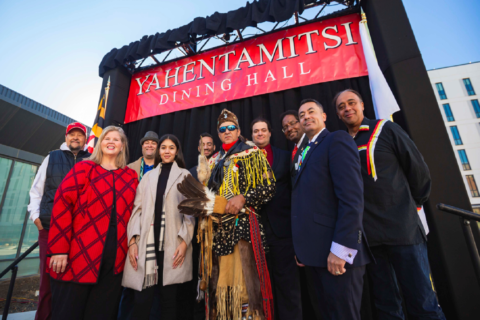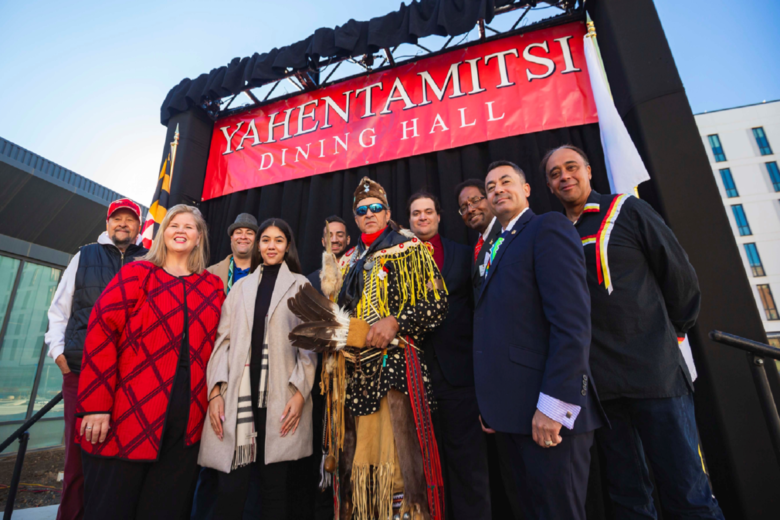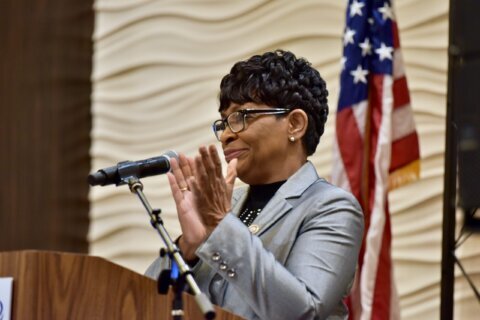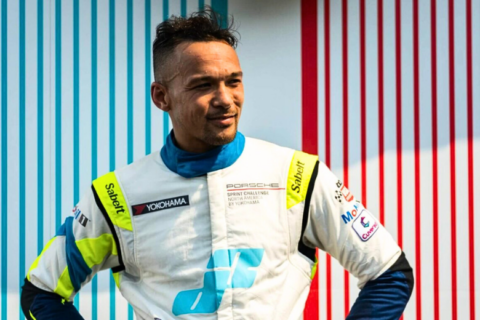
WASHINGTON, D.C. (AP) — In a ceremony marked by traditional songs and a ground blessing, the University of Maryland on Monday announced the name of its new dining hall: Yahentamitsi, named in honor of the state’s Piscataway Conoy Tribe.
Yahentamitsi (yah-HEN-tuh-MEET-see) will become the campus’s first new dining hall in nearly 50 years when it opens next fall, officials said. The naming ceremony was a first for Maryland’s flagship public university, coming as part of an effort to promote diversity and inclusion on the College Park campus, said Darryll J. Pines, the school’s president.
“This campus has been here for a very long time, yet most of us were blind to its history,” Pines told a crowd of about 50 people Monday, which marked the first day of Native American Heritage Month. “As a land-grant institution, I believe it is our responsibility to record, to interpret and to raise public awareness about tribal history. This effort was long overdue.”
Yahentamitsi, a name derived from the extinct Algonquin language once spoken by the Piscataway, translates to “a place to go to eat” and is the result of a collaboration between the university, the American Indian Student Union, and Piscataway elders and tribal members. The building will join two other recent additions — dormitories Johnson-Whittle Hall and Pyon-Chen Hall, which were named after some of the university’s first students of color — in an area of campus the school has dubbed the “Heritage Community.”
The dining hall, planned to comprise 60,000 square feet, will be the first building on campus to honor Indigenous people, Pines said. It will seat 1,000 people and feature a tribute to the Piscataway that will include art, artifacts and other educational materials from the tribe, said Patty Perillo, U-Md.’s vice president for student affairs.
In Monday’s ground-blessing ceremony, Maurice Proctor, an elder of the Piscataway Conoy Tribe, Cedarville Band, burned a bundle of sage and prayed for protection over the building and the people who will use it.
“For the first time, at this university, we’re recognized as a people, together,” Proctor said. “It’s a great day.”
The Piscataway are the Indigenous people of Maryland. But their land over time was colonized and their people forced out, often violently.
In recent years, groups throughout the D.C. region and across the country have made attempts to acknowledge that history, along with the brutal treatment of Indigenous peoples by Christopher Columbus and White settlers. Student groups and university officials will often start meetings, demonstrations and other events with a brief acknowledgment of the university’s presence on Piscataway land.
“Now we have a tradition where we will acknowledge the land that we’re building on,” Pines said in an interview. “We’ll think carefully about, can we use this as another opportunity to embrace our diversity?”
The university’s Indian American and Alaskan Native students — who comprise less than 1 percent of the student population — have the lowest six-year graduation rate at the university, at 75 percent, federal education data show. The university’s Asian students have the highest rate (89 percent), followed by White students (88 percent).
Jeremy Harley, a junior at U-Md. and president of the American Indian Student Union, said the university can do more to improve the student experience for young Indigenous people. One idea, the creation of a dedicated space for native students, could help students who “fall through the cracks” and serve as a “place to meet, to reach out and do educational stuff,” Harley suggested. Such a space could also attract more native students to the university, he added.
Harley’s brother, Brandon “Kota” Harley, who graduated from U-Md. in 2019, said the effort to honor the Piscataway had been in the works for at least four years. “Before, we really didn’t have the representation on campus,” he said, pointing to issues both with attracting and retaining Indigenous students.
But on Monday, after the ground blessing, he encouraged other institutions to follow his alma mater’s lead.
“It’s a great thing to do for the native community and show that the universities — not only here but across the country — want native youth,” Kota Harley said. “Hopefully this will be a precedent for other universities.”
Copyright © 2024 The Associated Press. All rights reserved. This material may not be published, broadcast, written or redistributed.








